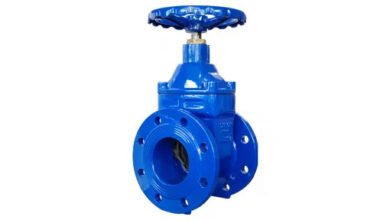Butterfly Valve with Pneumatic Actuator: A Comprehensive Guide

In the world of industrial valves, the butterfly valve with a pneumatic actuator holds a significant position. It is a versatile and reliable solution widely used in various industries, including oil and gas, water treatment, chemical, and many more. This article aims to provide you with a comprehensive guide to butterfly valves with pneumatic actuators, covering their functionality, benefits, applications, and key considerations. So let’s dive in and explore the fascinating world of butterfly valve with pneumatic actuator.
What Is a Butterfly Valve?
A butterfly valve is a quarter-turn rotational valve that is used to regulate the flow of fluids through a pipeline. It consists of a circular disc or plate, which is positioned at a right angle to the flow direction. The disc rotates within the valve body, allowing for precise control over the fluid flow. Butterfly valves are known for their simple construction, compact design, and quick operation.
Understanding Pneumatic Actuators
Pneumatic actuators are devices that convert energy from compressed air into mechanical motion. They are commonly used to automate various industrial processes, including valve operation. Pneumatic actuators offer advantages such as fast response times, high force output, and precise control. They are reliable and can be easily integrated into different systems.
The Combination: Butterfly Valve with Pneumatic Actuator
When a butterfly valve is equipped with a pneumatic actuator, it becomes an efficient automated solution. The actuator controls the rotation of the disc, allowing for remote and automatic operation of the valve. By using compressed air, the actuator can swiftly open or close the valve, providing accurate control over the fluid flow. This combination is highly preferred in applications where frequent valve adjustments, tight shut-off, and quick response are required.
Working Principle of Butterfly Valves
Butterfly valves operate on a simple yet effective principle. When the valve is in the fully open position, the disc aligns with the direction of flow, minimizing any obstruction. By rotating the disc, the flow can regulate from fully open to fully close. The disc can also position at any angle in between to control the flow rate. This flexibility makes butterfly valves suitable for both on/off and throttling applications.
Advantages of Butterfly Valves with Pneumatic Actuators
- Quick and Reliable Operation: Butterfly valves with pneumatic actuators offer rapid response times, enabling efficient control over the fluid flow. The actuator’s ability to open or close the valve swiftly ensures prompt adjustments in critical processes.
- Space and Weight Savings: The compact design of butterfly valves results in reduced space requirements. Additionally, the lightweight construction allows for easier installation and transportation.
- Cost-Effectiveness: Butterfly valves with pneumatic actuators are often more cost-effective compared to other valve types. They require fewer components and have lower maintenance costs, making them a budget-friendly choice for many industries.
- Good Flow Control: The design of butterfly valves allows for precise regulation of flow rates, making them suitable for applications that require accurate control over fluid flow.
Applications of Butterfly Valves with Pneumatic Actuators
Butterfly valves with pneumatic actuators find applications in a wide range of industries, including:
- Oil and Gas: These valves are use in pipelines, refineries, storage tanks, and offshore platforms for flow control and isolation.
- Water Treatment: Butterfly valves play a crucial role in water treatment plants, facilitating the control of water flow and distribution.
- Chemical Industry: The chemical industry utilizes butterfly valves to regulate the flow of various chemicals in processes such as mixing, blending, and transportation.
- HVAC Systems: To control the flow of water and air, heating, ventilation, and air conditioning systems use butterfly valves.
- Food and Beverage: These valves are use in food processing and beverage production, ensuring precise control over the flow of ingredients and fluids.
Key Considerations for Selecting Butterfly Valves with Pneumatic Actuators
When choosing butterfly valves with pneumatic actuators, several factors should be taken into account:
- Valve Size and Pressure Rating: Ensure that the valve size and pressure rating meets the requirements of your application.
- Actuator Type and Operating Pressure: Select the appropriate actuator type and ensure it can handle the required operating pressure.
- Material Compatibility: Consider the compatibility of the valve and actuator materials with the fluid being transport to avoid corrosion or contamination.
- End Connections: Choose the appropriate end connections (flanged, wafer, lug) based on your piping system requirements.
- Automation and Control Integration: Evaluate the compatibility of the valve and actuator with the existing control system for seamless integration.
Installation and Maintenance of Butterfly Valves
Proper installation and maintenance are essential for the optimal performance and longevity of butterfly valves with pneumatic actuators. Follow these guidelines:
- Installation: Ensure correct alignment, tight bolting, and proper gasket selection. Follow manufacturer guidelines for actuator mounting and coupling.
- Maintenance: Regularly inspect and clean the valve and actuator. Lubricate moving parts as recommended. Periodically check for leaks and damaged components.
Comparing Butterfly Valves with Other Valve Types
Butterfly valves have distinct advantages over other valve types:
- Ball Valves: Butterfly valves are lighter, more compact, and cost-effective compared to ball valves. They offer better flow control and lower pressure drops.
- Gate Valves: Butterfly valves require less maintenance and have faster operation times than gate valves. They also occupy less space and are more economical.
- Globe Valves: Butterfly valves offer comparable flow control capabilities to globe valves but with simpler construction, lower cost, and easier maintenance.
Future Trends and Innovations in Butterfly Valves
The field of butterfly valves with pneumatic actuators is witnessing continuous advancements. Some notable trends and innovations include:
- Smart Valve Technology: Integration of sensors and communication capabilities into butterfly valves for enhanced monitoring, diagnostics, and control.
- Energy Efficiency: Development of more energy-efficient actuators and valve designs to minimize power consumption and improve sustainability.
- Improved Material Selection: Advancements in material science to enhance valve performance, durability, and resistance to corrosive environments.
- Digitalization and Automation: Integration of butterfly valves with pneumatic actuators into digital control systems and automation platforms for increased efficiency and ease of operation.
Conclusion
Butterfly valves with pneumatic actuators provide a reliable and efficient solution for fluid flow control in various industries. Their compact design, cost-effectiveness, and quick operation make them a preferred choice for many applications. By understanding the working principle, benefits, applications, and key considerations associated with these valves, you can make informed decisions when selecting and implementing them in your systems.




